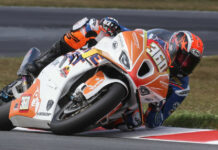By John Ulrich A lot of good has come out of Daytona Motorsports Group (DMG) buying AMA Pro Racing from the American Motorcyclist Association (AMA) and taking over running the series starting in 2009. The greatest good to come out of the deal is the fact that AMA Pro Racing is no longer bleeding cash from AMA, which had basically blown serious money propping up its for-profit racing subsidiary (known as Paradama, at the time dba AMA Pro Racing) over the course of a little more than a decade. In fact, the first $1.9 million payment DMG made to AMA in 2009 made up for the AMA-to-AMA-Pro subsidies made in the previous 12 years. By the time the final installment is paid, payments from DMG to AMA will approach $12 million. The timing could not have been better for AMA. The sale of AMA Pro Racing to DMG came just before the economy tanked. Cash flow coming in from the sale replaced cash going out to a money-losing operation that AMA never really figured out how to run right. Combined with downsizing and professional management, the sale helped transform AMA from an organization in a financial death spiral into what today appears to be a sustainable business with $10 million in reserves. The AMA is the first line of defense against unwarranted government restrictions on the sport of motorcycling, one example being a late-1980s U.S. Senate proposal to ban sportbikes as being too fast and too dangerous. Another example would be the much more recent ban on the sale of small motorcycles and ATVs meant for kids””thanks to an over-reaching law that limited lead content of products aimed at children, because ingesting lead can cause developmental problems. Obviously, there’s a big difference between a toy truck covered in paint that contains lead and a minibike or ATV that has lead battery terminals hidden underneath the seat, non the least being that kids old enough to ride aren’t likely to be chewing on their minibike or ATV! The AMA””working with the Motorcycle Industry Council (MIC) and other groups– had a key role in overturning the ban. But the threat of other outlandish restrictions is a continuing fact of life, and it’s important to have a user group (the AMA) pushing back against what then-seven-year-old Hayley Ulrich once described (while testifying during a mid-1980s Consumer Product Safety Commission hearing into whether or not ATVs should be banned altogether) as “the government guys.” So far so good. But with that good came an incredible evil, in the form of the disastrous 2009 season that saw AMA Pro Racing under the new DMG management institute and embrace the worst kind of vindictive officiating. AMA Pro Racing Timing & Scoring officials went so far as to issue targeted, unjustified ride-through penalties to punish riders for (even well-deserved) criticism of the regime, or, in the worst case, just for associating with others who had criticized the regime or who had pointed out when timing and scoring didn’t work during event weekends! This practice was so vile and so far removed from fair sports officiating that even I couldn’t believe it was actually happening until well afterward, when 2009 Race Director Colin Fraser personally confirmed to me that the corruption had been going on from the start of the season. Asked why he didn’t stop it, Fraser told me that the timing and scoring officials didn’t report to him. DMG COO David Atlas also confirmed that selected riders had been targeted by timing and scoring officials, one of whom later bragged publicly that “I was looking for pixel movement (on the video monitor screen) and I found it.” Said timing and scoring officials often only reviewed the starts of targeted riders, and weren’t concerned whether or not said “pixel movement” had resulted in somebody getting an advantage at the start. Even brief fork compression without front-wheel movement, followed by the bike being absolutely stationary again before (and when) the lights went out, was enough to bring down a targeted penalty. (I would have liked to see the involved lunatic officials grid up on a Superbike and try to get the rpm perfectly right and the clutch just below the engagement point while waiting for the lights to go out, without a pixel width of movement!) Meanwhile, after five riders were busted in a single AMA Pro Superbike race at Road America mid-year and before I even knew why the penalties were flowing, I talked to DMG’s then-President Roger Edmondson about the craziness of giving anybody a ride-through penalty if they weren’t actually moving forward when the lights went out to signal the official start. Edmondson told me that he agreed and would end the practice immediately. He didn’t: Targeted riders continued to get bogus ride-through penalties through the season finale weekend at New Jersey Motorsports Park. There were plenty of other examples of terrible, corrupt officiating during the 2009 season, most of them coming down to ignoring what the rulebook actually said and abandoning any attempt to use common sense, be fair or do the right thing. To his credit, majority DMG owner Jim France (his minority partners are currently Atlas, Chris Harris and Tom Bledsoe) basically sent Edmondson down the road and put Atlas in charge before the start of the 2010 season. Atlas in turn either fired or didn’t renew the contracts of a slew of 2009-season officials, including the involved timing and scoring miscreants. Former racer and then-current crew chief David McGrath was hired to replace Fraser, while profane-yet-effective tech boss Al Ludington””also a former factory team mechanic–survived the purge. Generally speaking, things were looking up. The dark mood that had settled in over the 2009 paddock lifted, while on-track competition and general officiating continued to improve. It was more of the same for most of 2011. But acknowledgment that AMA Pro Racing (and its DMG management) was doing a better job apparently made officials more willing to ignore the biggest lessons of AMA Pro Racing history and to believe that their own professional discretion and standing as “Officials with a Capital O” was more valuable than the intent or actual wording of the rulebook. Call it the Eric Cartman Syndrome, or ECS, based on the Southpark animated adult TV show character prone to demanding that people “Respect Ma Au-Thor-A-Te.” It also led to a personalization of every criticism, well-intended or not. The management style evolved into being “friend” based (without any online involvement) with a strong thread of enemies-list “You’re with us or against us” seasoning. By late 2011, even saying in private that an AMA Pro Racing official or DMG functionary lacked perspective on an issue or was setting the company up to repeat the mistakes of history, brought the same reaction as one would expect from saying, “Your Mother Is A Whore,” or YMIAW. Resulting expressions of angst and even fits of crying during meetings made professional dialog difficult if not impossible. More on those disturbing trends later. Underlying this is DMG management’s failure to ensure that everybody in the company follows a standard operations manual””if the company has an operations manual at all. I’ve been advocating that AMA Pro Racing develop and religiously follow an operations manual for over a decade. One of the few commonalities between the current AMA Pro Racing regime under DMG management and past AMA Pro Racing regimes under Paradama management has been to uniformly ignore that advice, to the peril of everybody involved. The type of thing such an operations manual might cover, for example, is the need to consider timing. As in, it takes teams and riders time to design and implement graphics packages for motorcycles and leathers. So, for example, if you’re going to require riders to have official class sponsor logos in a specific location on their leathers, you probably should tell them months in advance instead of about five weeks before they have to be in Daytona for the season opener, to allow time to design the leathers layout, get the leathers built, take photos for posters and PR use, etc. It’s even more basic that participation in points-fund programs should be voluntary based on a positive””the ability to earn money and support the series””instead of mandatory based on a negative””the threat of losing purse, points and grid position, as well as being suspended. Really, what company executive in his or her right mind would sign up for an AMA Pro class sponsorship program that, for example, would force a rider to wear leathers displaying the logo of a company that competes with his or her primary sponsor? If a competing insurance company became a series sponsor, how happy would Foremost Insurance Pegram Racing’s Larry Pegram be if he was forced to display that competing insurance company’s logo on his leathers? The fiction that any publicity is good publicity would probably not apply in that example! Amazingly, DMG managers have followed common sense in AMA Pro dirt track as recently as the 2011 season, with riders who have competing sponsors allowed to opt out of points fund programs and NOT run a class sponsor logo on their leathers. You’d think that applying the same reasoned approach in road racing for 2012 would be a given. That’s not what happened. Note the terms “partnership” and “partner” in the following clips: On November 21st, 2011, AMA Pro Racing issued a press release that started out, “Officials from AMA Pro Racing and the Army National Guard announced today an extension of their existing partnership”¦” On December 21st, 2011, AMA Pro Racing issued a press release that started out, “Officials from AMA Pro Racing and GoPro® have announced an exclusive multi-year partnership”¦” On February 3rd, 2012, AMA Pro Racing issued a bulletin stating that after the season-opener at Daytona, “Failure to affix required partner logos by the next event could result in one or more of the following penalties: Fine, gridding to the back field, loss of championship points, suspension.” To back up that bulletin, a DMG employee called leathers suppliers and said that class sponsor logos were absolutely mandatory and that riders who did not run them would be penalized. When told by one of the leathers suppliers that it was way too late to accommodate that requirement on leathers already in production overseas, the DMG employee repeated that the logos had to be on the leathers and, in the words of the leathers supplier, “Got pretty snippy with me.” Later that same day, David Atlas told me that the class sponsor patches would not be mandatory and that riders could opt out, as they did in dirt track last season. And on February 7th, 2012, AMA Pro Racing issued a series of bulletins referring to running class sponsor logos as a condition of earning points fund money without listing draconian penalties for not running the patches. But on March 2nd, 2012, AMA Pro Racing issued another bulletin stating that after a warning at one event, “Failure to affix required exclusive partner logos by the next event could result in one or more of the following penalties: Ineligibility for event general purse, additional fine, gridding to the back of the field, loss of championship points, suspension.” By early March 3rd, official anguish over online reaction was in full display, complete with this text message assertion (and perhaps an implied threat), from one AMA Pro official: “Know that I take it 100% personal.” (See “YMIAW” as referenced earlier.) For all I know, there have already been tears shed in a meeting at DMG headquarters. It is clear that AMA Pro Racing’s position on class sponsor logos has changed to some degree since February 3rd when a bulletin was issued and official phone calls made, warning of draconian penalties for not putting mandatory class sponsor logos in the mandated position on leathers already in production in places like Italy, Japan and the United States. (The timing issue also creates problems for a rider with an existing sponsor deal negotiated in a timely fashion, requiring a logo in a specific place on his or her leathers. In one case that I know of, the mandated positioning of the class sponsor logo announced February 3rd would have displaced the logo positioning of a well-paying sponsor negotiated months earlier! Add that to the fact that AMA Pro Racing’s requirement that its series logo be placed on the rider’s chest is more restrictive and burns up more prime sponsorship real-estate than the placement required by the MotoGP World Championship, the Superbike World Championship and the British Superbike Championship.) Assorted officials now say that the penalties only apply to the AMA Pro Racing logo and the logos of spec tire and spec fuel sponsors Dunlop and Sunoco, respectively. Following an operations manual based on proven best practices and the lessons of history would have gone a long way toward delivering a well-considered, consistent, reasonable, timely message to all involved. As would have precise language in a follow-up press release clearly stating what the policy actually is, along the lines of the following suggested text offered free of charge: “To clear up any unintended confusion, riders must display class sponsor logos in the specified position on their leathers to participate in a class points fund. All riders must display spec tire, spec fuel and AMA Pro Racing logos on their leathers to participate in AMA Pro Racing events.” More to follow…
FIRST PERSON/OPINION: AMA Pro Racing At A Crossroads, Part 1
FIRST PERSON/OPINION: AMA Pro Racing At A Crossroads, Part 1
© 2012, Roadracing World Publishing, Inc.






